Before we make any buying decisions, most of us go through the same process. One of the first things we do is look for reviews and opinions about the product or service we’re considering.
This is often referred to as social proof – basically the need for people to look to others for information on how to make a good decision. There’s a ton of different types of sources of social proof out there, but in this post we're going to focus on the online sources of social proof, like Facebook, Twitter, Google, Yelp and other review sites.
As a small business owner, reviews can be a huge driver of revenue, but they can also have a negative effect. It isn’t necessarily the TYPE of review you receive, but more of how you deal with the review in question.
Each review you receive is an opportunity to thank a customer for their business or try and remedy a bad situation. Actively engaging with reviews and customer questions and comments is a great way to build trust with your existing customers, and keep new ones coming through the door.
As a social media manager, I’ve dealt with a LOT of customer opinions and reviews, both good and bad. Some days (or weeks) it seems all you’re getting is flak for some mistake you made that you’ve already apologized for, and you really just want to hide under your desk.
Fear not! Remember to take a deep breath, step back and remember that there’s always a chance to turn the situation around.
Why You Should Care About Social Proof
We all know one of the most powerful types of marking is word of mouth and recommendations. So, it makes sense that it should be something that you pay attention to closely. For a small business, the more free marketing, the better!
For the data geeks out there, you can find a ton of surveys and studies about the power of social proof. One such survey found that 79% of online shoppers tend to trust online reviews as much as recommendations from friends and family.
Plus, 30% of respondents to the same survey said that they are likely to trust online reviews just as much as a personal recommendation, provided that the reviews are authentic.
And this trend is only going up. Check out what happened between 2011 and 2013:
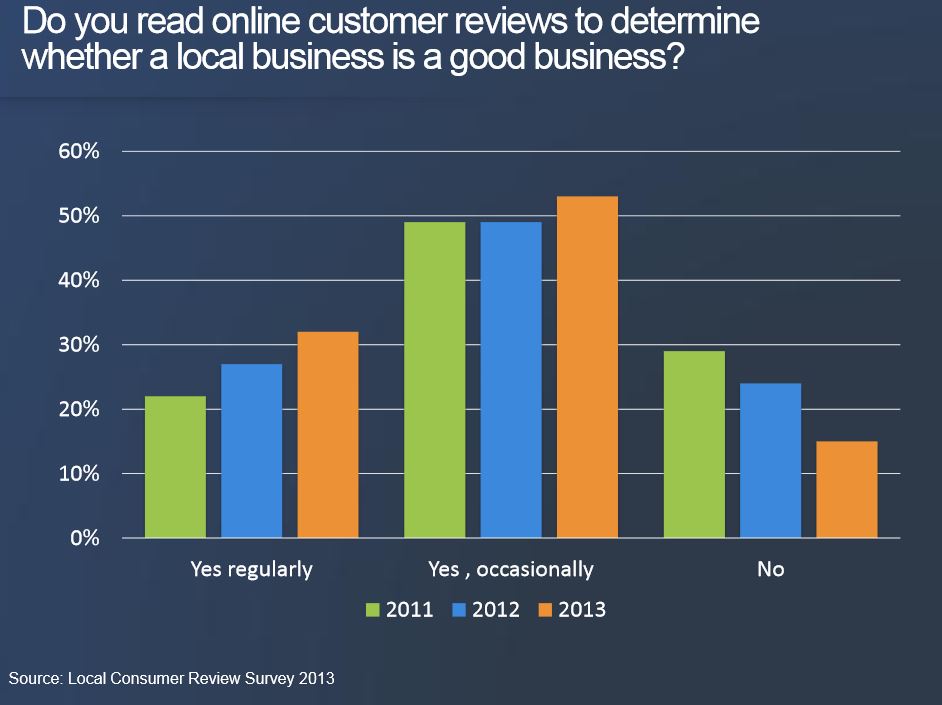
So what does that mean for you? It means that your customers have so many places to find information about your business at their fingertips, and you need to make sure you monitor as much of the conversation as possible.
Jump in wherever you can. Make yourself visible. The more active you are, the more trust you’ll build with your customer base and the more new customers you’ll attract.
How to Monitor What People Are Saying
With so many places for people to be talking about you, it may seem overwhelming to know where to start listening. There’s a lot of tools that you can use to monitor mentions of your business in social media and on the web, many of which are free.
Google Alerts
To monitor mentions of your business name on the web, Google Alerts is a good way to go. You can set up a scheduled email alert to be sent to you based on the frequency you choose, and you can have as many alerts as possible. Here’s a snapshot of the alerts I have set up for Grasshopper:

You have the choice of getting only the most relevant results, but I like to set it to all results just in case (which results in getting a lot of emails about the grasshopper mouse that’s immune to a scorpion sting).
If you don’t use Gmail, you can just create a Google account and have the alerts forwarded to the email address of your choice.
There are a couple of options here to get alerted when someone leaves a comment on your Facebook page. One option is to set up your notifications to appear every time there’s any activity on your page. It’s under your Notifications Settings and looks like this (don’t judge the other pages I manage):
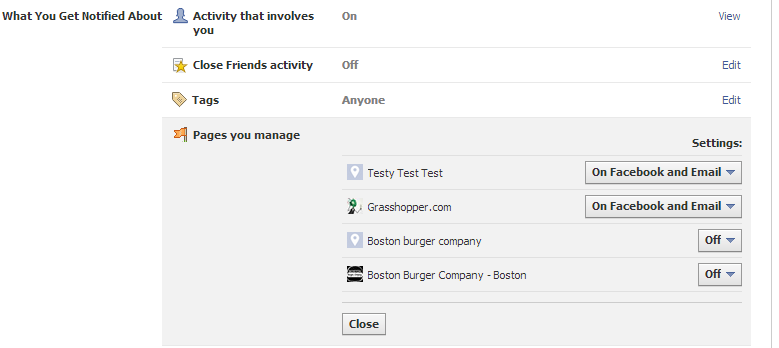
I get an email and a Facebook notification every time there’s any type of activity on the Grasshopper page. This way, I’m able to see comments real-time and am able to respond to anything that’s an emergency.
To me, Twitter is one of the more important places to listen, and I also feel it tends to get neglected. Its super simple for someone to pull out their phone and write a 140-character quip about a bad experience with your business, and it’s out there for all of the internet to see. There are a few different resources that you can use to listen to your customers, so you have no excuse!
First, and most obviously, you can just use Twitter itself. Just sign in and click on the “Connect” tab, and you can see all the activity by other users that’s associated with your handle. From there, you can reply, favorite and Retweet to your heart’s content!
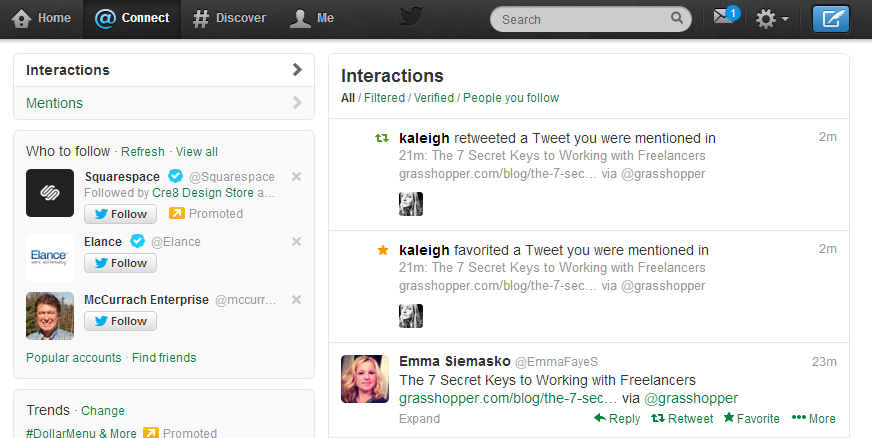
Personally, I like to use TweetDeck, which is a downloadable platform created by Twitter. I monitor a lot of keywords and different lists, and it’s easier for me to see it all in one place. Plus, it updates real time, so I don’t have to keep clicking the refresh button to see new activity.
Here’s what my TweetDeck looks like:
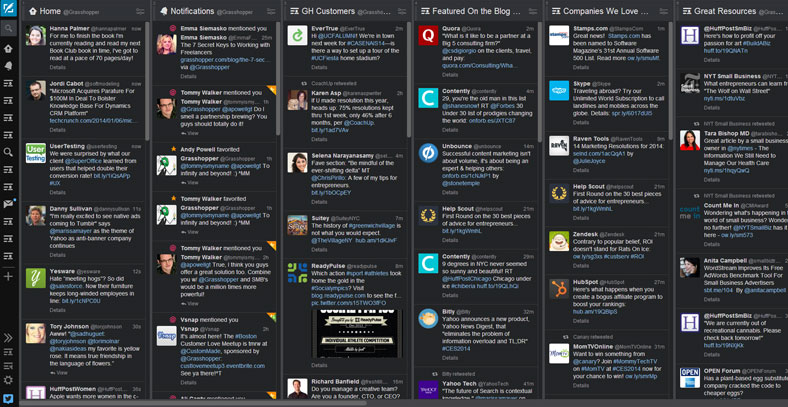
You absolutely don’t need to have a set up as intense as mine – even I get overwhelmed by it sometimes! I would recommend having a few different searches set up for different variations of your business name (with and without hashtags), just to make sure nothing falls through the cracks.
Review Sites
Most review sites allow you to “claim” your business, therefore allowing you to respond to reviews that your customers post. If you can, set up email alerts for those as well. If not, create some sort of reminder so you can make sure you check in on a regular basis.
You Got a Bad Review – Start Sweating
Break out the antiperspirant, people – you got an alert for a bad comment made by someone!
The initial reaction to someone posting a bad review about your business is usually upsetting – you probably feel personally attacked, especially since your business is your pride and joy!
I’ve had plenty of instances where I’ve been bothered, even downright angry, by what someone said about my company on social media or in a review. However, the key is to not let that affect your response. It’s about building trust and righting a wrong, not kicking someone else in the shin.
Depending on the channel, you may have to take the conversation with the customer offline. This is particularly true with Twitter, where having a constructive conversation can be difficult when you’re only allowed 140 characters per tweet.
Here’s an example from Chobani’s Facebook page:

Chobani’s response is really great. Here’s why:
-
They acknowledged the problem and admitted it’s their fault
-
They took the conversation offline to get some information from the customer
-
They stated they’ll be taking steps to get to the bottom of the problem
-
They are most likely going to send the customer free cups (hence asking for the address)
They didn’t take offense to the customer’s comment – they were courteous, polite and to the point. Once this customer is taken care of, it’s a pretty good bet they’ll go back to being the brand evangelist they were before.
How to Cope with Inconsolable Customers
But let’s be honest – comments and reviews aren’t always going to be that black and white. Once in a while, you may get a customer who is inconsolable, hostile, or beyond upset. I handled social media for an online financial institution before coming to Grasshopper, so believe me, I saw a lot of that.
The difference with these types of situations is that at the end of the day, you have to have a point where you walk away. If you’ve apologized, said all you can say, and attempted (or succeeded) at fixing the situation, and the customer is still upset, there’s nothing more that you can do. The important thing is that you’ve demonstrated publicly that you care about fixing the situation, which in the long run ends up benefiting you as the business owner.
How to Respond to a Good Review
Ok, enough with the bad stuff. What should you do when you get a GOOD comment? Well, first, do your happy dance! (I’ll wait.)
Seriously, though, acknowledging good reviews is just as important as reacting to bad ones. Why? Because you want to build relationships with your customers who already love you! These are the people who are going to tell their mom, hairdresser, taxi driver, dog walker, and second cousin twice removed about you. Make them feel important, and they’ll pound the pavement for you.
Take this tweet from the Boston-based payments app LevelUp:
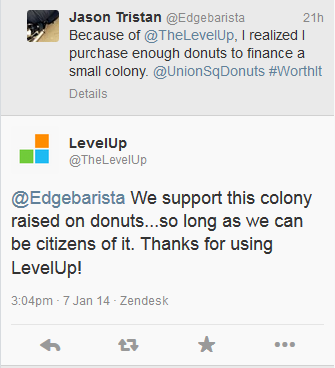
They got a mention on Twitter from one of their users, and took it as an opportunity to thank them in a way that injected personality into their response. Nothing complicated, just a simple “Thanks for being a customer.” Couldn’t be easier!
If you have the resources, it’s also a good idea to surprise and delight your happy customers with handwritten notes thanking them for their comments. We do this all the time at Grasshopper, and it’s as fun for us as it is for our customers! If you can devote even 20 minutes a week to doing this, trust me, it’s worth it.
Creating Trust is Key
At the end of the day, your goal is to engage with your customers and build trust with them. Showing that you’re out in the social community, listening and responding to customers, is the best way to do that. Make them feel like they’re valued, and that they can come to you with anything they have to say, be it good or bad.
The more you interact with your customers, the more willing they’ll be to recommend you to their social circles, and go to bat for you when something goes wrong.
Your Turn: Have you had any notable experiences with companies or customers online? What's happened when you've made a comment or complaint on a review site? I'm dying to know!


